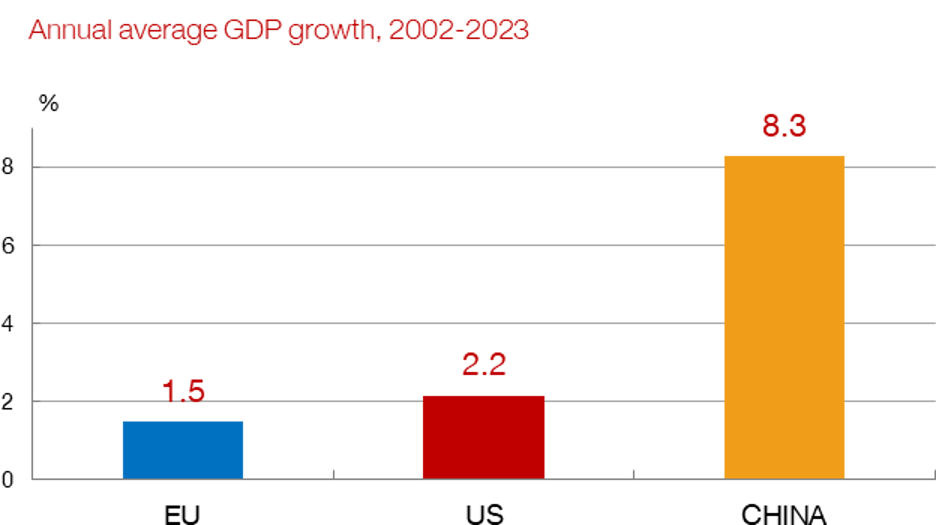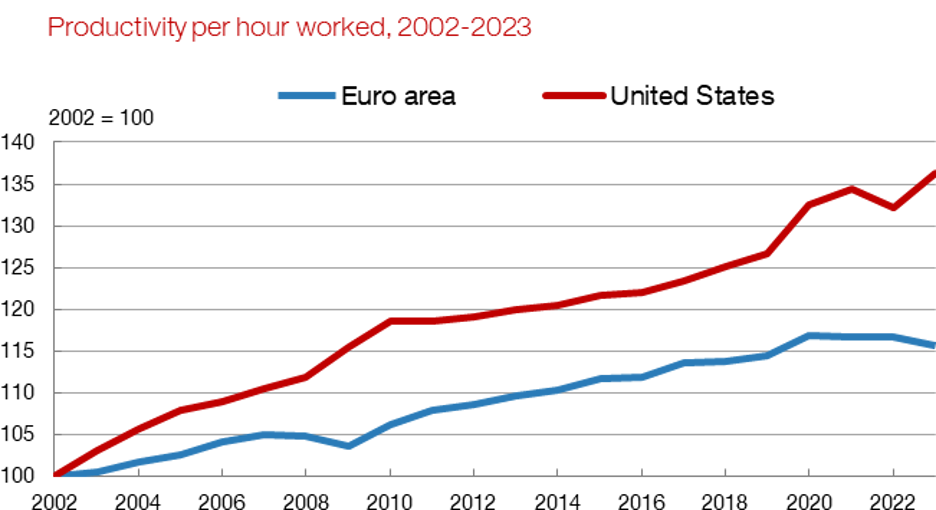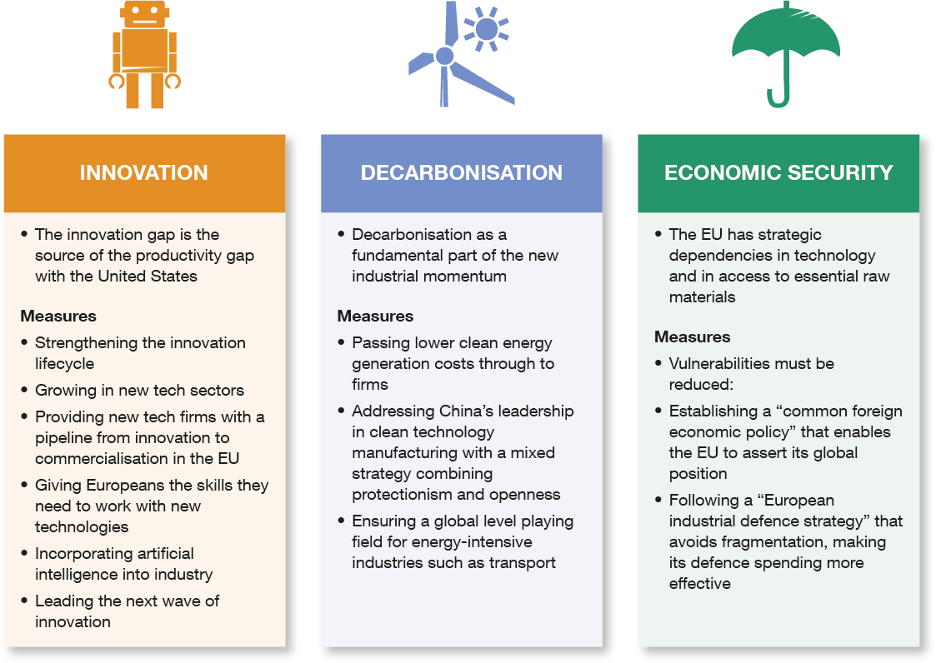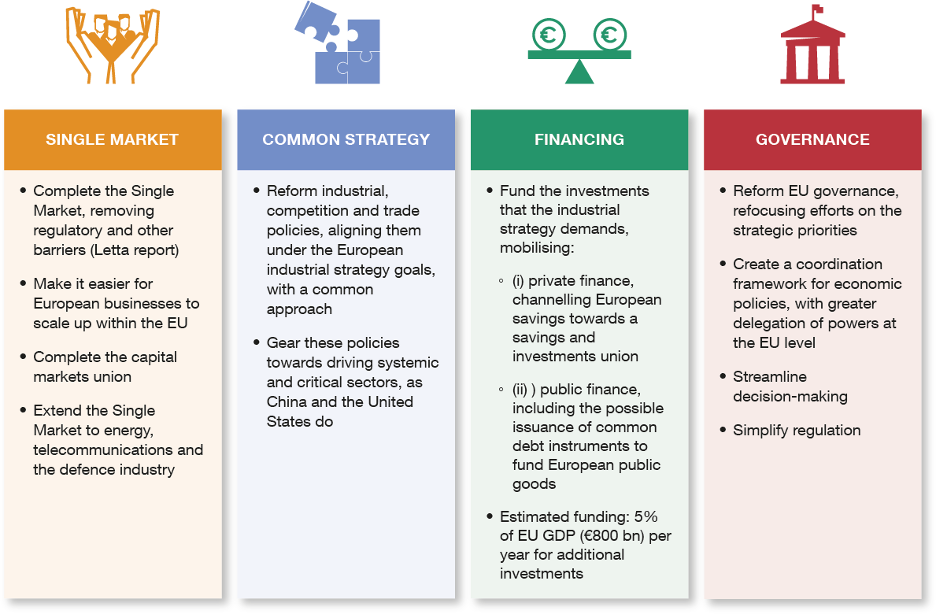The Draghi report: a plan for the economic future of Europe
The Draghi report proposes a strategy to halt the economic decline of the European Union compared with other global powers. A common European approach focused on growth is needed if the EU is to successfully address the challenges it faces: technological transformation, decarbonisation, economic security and preservation of the European social model.
The new European Commission![]() led by Ursula von der Leyen faces a formidable challenge: to reverse Europe's economic decline in a changing and not necessarily favourable global landscape. The Draghi report
led by Ursula von der Leyen faces a formidable challenge: to reverse Europe's economic decline in a changing and not necessarily favourable global landscape. The Draghi report![]() offers a roadmap for the European Union (EU) to regain its economic strength. So what measures does it propose to meet this challenge and what tools are needed to successfully navigate the journey?
offers a roadmap for the European Union (EU) to regain its economic strength. So what measures does it propose to meet this challenge and what tools are needed to successfully navigate the journey?
The new Commission’s first task will be to approve its work programme: a set of measures that will determine the direction EU policies take over the next five years. In preparation, the outgoing European Council![]() and Commission launched a reflection on the EU’s future strategic orientation in the economic field, which included a report commissioned from Mario Draghi
and Commission launched a reflection on the EU’s future strategic orientation in the economic field, which included a report commissioned from Mario Draghi![]() . Although not published until September, the report, entitled “EU competitiveness: Looking ahead”, played an important role in defining the Political Guidelines
. Although not published until September, the report, entitled “EU competitiveness: Looking ahead”, played an important role in defining the Political Guidelines![]() that Von der Leyen presented to the European Parliament in July in her bid to lead the new Commission.
that Von der Leyen presented to the European Parliament in July in her bid to lead the new Commission.
Diagnosis
The report provides a clear diagnosis of the European Union’s economic decline compared with the United States and China, in an increasingly polarised global landscape.
As Chart 1 shows, over the last two decades the EU has grown less than the United States and China and has lost global share. Europe’s low productivity growth, which has held back its competitiveness, is behind this loss.
Chart 1
GROWTH AND PRODUCTIVITY GAPS

SOURCE: World Economic Outlook, IMF

SOURCE: OECD
Over the last two decades the global environment has also become more challenging:
- international trade has slowed;
- competition from China has intensified in key sectors for European industry;
- technological change has accelerated and Europe is not a leader in new tech;
- Russia is no longer a cheap energy supplier;
- the US is no longer a guarantor of global geopolitical stability.
In the past, Europe’s trade openness and commercial strength buffered the effects of its low economic growth. However, in the new geopolitical setting, such external interdependencies have become sources of vulnerability for Europe.
Roadmap
How can Europe prosper in this new environment? The solution, as ever, is to boost its productivity and growth potential. Indeed, this is an existential challenge for the EU: without growth, Europe will continue to lose global share and the sustainability of the European social model![]() – which together with economic integration is one of the foundations of the European project – will be threatened.
– which together with economic integration is one of the foundations of the European project – will be threatened.
For the European Union, increasing its growth potential is an existential challenge. If not addressed, it could threaten the European social model and the entire European project
How can the EU increase its long-term growth capacity? The Draghi report identifies three transformations: innovation, decarbonisation and economic security. These are the levers needed to boost productivity and growth and together they form an industrial development strategy for Europe. Figure 1 outlines the main measures needed in each area.
The first two transformations are linked to the twin – digital and green – transitions that have guided the EU’s economic strategy in recent years, albeit taking a new approach. The third is linked to the need to improve Europe’s economic security and defence capacity.
Figure 1
THE NEW EUROPEAN INDUSTRIAL STRATEGY: THREE TRANSFORMATIONS

SOURCES: EU competitiveness: Looking ahead (the Draghi report)![]() , Banco de España
, Banco de España
How should the strategy be taken forward? The EU must substantially change the way it conducts economic policy. Acting separately, the Member States lack sufficient global influence to prosper; a genuinely European approach is needed, one that includes the financing of the investments that the transformation demands. Only by working as one will the EU be able to implement the required policies and investments.
What are the key elements of this common approach? The Draghi report identifies four main building blocks: the Single Market, a shared overall strategy, common financing and good governance (see Figure 2).
Figure 2
THE NEW EUROPEAN INDUSTRIAL STRATEGY: KEY BUILDING BLOCKS

SOURCES: EU competitiveness: Looking ahead (Draghi report)![]() , Banco de España
, Banco de España
The report outlines a broad set of specific measures to drive each of the transformations and reinforce the building blocks of the common strategy. Taken as a whole, it provides a plan for the future and a roadmap with a clear destination: a more competitive EU.
The Draghi report provides a plan for the future and a roadmap with a clear destination: a more competitive EU
This comprehensive approach means long-standing EU initiatives can be accommodated. One example is completing the capital markets union (CMU)![]() , which, as discussed in a recent blog entry
, which, as discussed in a recent blog entry![]() , has become more urgent in light of the need to finance the lift-off of European innovation.
, has become more urgent in light of the need to finance the lift-off of European innovation.
The impact of the Draghi report
The Draghi report, along with other analyses such as the Letta report![]() on the single European market, is actively used in debates about the new European Commission’s work programme. The Eurogroup
on the single European market, is actively used in debates about the new European Commission’s work programme. The Eurogroup![]() and the European Council
and the European Council![]() have proposed a new European Competitiveness Deal, with specific mandates for the new Commission that reflect the main proposals set out by Draghi and Letta. Von der Leyen herself cited the reports in her mission letters to the Commissioners-designate
have proposed a new European Competitiveness Deal, with specific mandates for the new Commission that reflect the main proposals set out by Draghi and Letta. Von der Leyen herself cited the reports in her mission letters to the Commissioners-designate![]() .
.
The new Commission’s priority initiatives are expected to include:
- a broad European industrial strategy geared towards technological leadership;
- a horizontal strategy for the Single Market and business growth;
- progress towards the savings and investments union, with renewed efforts to achieve the CMU and the development of venture capital markets and European savings products;
- development of the energy union, including interconnections;
- definition of a strategy for the defence industry;
- in particular, a technology, digitalisation, innovation and data strategy.
The Draghi report’s unequivocal call for a shift in the EU’s policy direction has widespread support. However, many of the specific proposals are controversial. The Member States have drawn – in some cases conflicting – red lines on issues such as common funding. Moreover, European policies can only be remodelled if the inertia within European institutions themselves can be overcome. But the “existential challenge” described by Draghi will only intensify with time. It must be met with firm political will.
DISCLAIMER: The views expressed in this blog post are those of the author(s) and do not necessarily coincide with those of the Banco de España or the Eurosystem.

